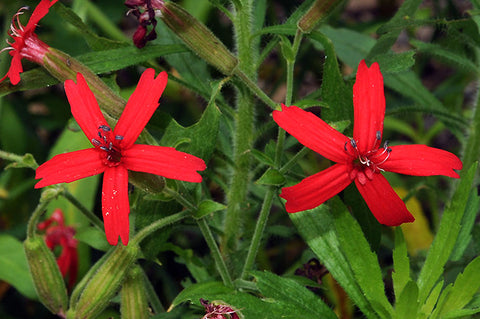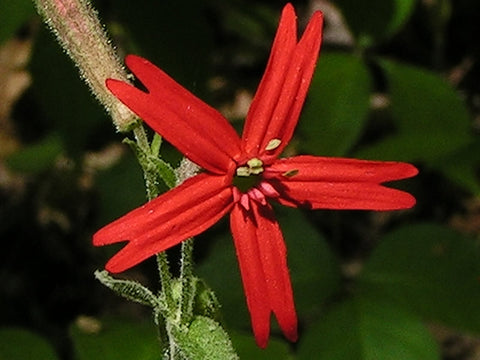

Fire Pink: A Beauty for Gardens
Fire Pink is a beautiful, native wildflower that colors gardens and other parts of nature. Known for its red flowers, this perennial plant is a favorite among nature lovers.
The species name Virginica refers to its native region in the eastern United States, particularly from the Appalachian Mountains down to the Gulf Coast. The plant gets its common name from the bright, fiery red color of its blossoms, which resemble the vivid hues of a flame. Fire Pink is often called "Red Campion," though it should not be confused with the European variety of Silene.
Physical Characteristics of the Fire Pink
Fire Pink typically grows 1 to 2 feet tall, forming a somewhat upright, clump-like structure. Its slender, erect stems are adorned with narrow, lance-shaped leaves that are light green and slightly sticky. In late spring to early summer, Fire Pink produces clusters of small, vibrant red flowers with five deeply notched petals that open into a star-like shape. These flowers are usually 1 to 1.5 inches in diameter.
The plant's striking red blooms are not only eye-catching to humans. Still, they are also important to pollinators, including hummingbirds and butterflies drawn to the nectar-rich flowers.
What are the growing conditions for Fire Pink?
- Light Requirements: Fire Pink prefers partial to full sun, though it can handle some light shade. The plant may not bloom profusely in shadier locations but will grow well.
- Soil: It thrives in well-draining, slightly acidic to neutral soils. Fire Pink is adaptable to various soil types, but it does best in moist, fertile soil with good organic matter content. It does not like overly wet or soggy soils.
- Watering: While Fire Pink is somewhat drought-tolerant once established, it does benefit from consistent moisture, especially during its flowering period. Regular watering is essential, but ensure the soil has proper drainage to avoid root rot.
- Temperature and Hardiness: Fire Pink is hardy in USDA hardiness zones 4-9. It prefers moderate temperatures and cannot handle hot or dry conditions. However, it can handle a range of climates as long as it is kept sufficiently watered.
Care and Maintenance
Fire Pink is a relatively low-maintenance plant, but a few simple steps can help make sure it thrives:
- Deadheading: To encourage additional blooms and keep the plant looking tidy, remove spent flowers (deadheading) as soon as they fade. This can also prevent the plant from reproducing excessively.
- Pruning: Fire Pink doesn't require much pruning, but if the plant becomes leggy or overgrown, you can trim it after flowering to maintain a neat appearance.
- Fertilization: While Fire Pink doesn't need heavy fertilization, a touch of balanced fertilizer in early spring can promote vigorous growth. However, avoid over-fertilizing, resulting in lush foliage with fewer flowers.
Fire Pink is pest-resistant but can sometimes attract aphids, caterpillars, and other insects. If pests become a problem, consider trying organic pest control, such as insecticidal soap, or introducing natural predators like ladybugs.
Diseases are not usually an issue with Fire Pink, but the plant can suffer from mildew if there is poor air circulation and excessive moisture.
Fire Pink in Landscaping
Due to its eye-catching color and ease of care, Fire Pink is an excellent addition to wildflower gardens, native plantings, and naturalized landscapes. Here are a few ideas for incorporating Fire Pink into your landscape:
- Wildflower Gardens: Fire Pink makes a stunning focal point in wildflower gardens. Pair it with other native plants such as Black-eyed Susans, Purple Coneflower, or Butterfly Weed for a colorful, pollinator-friendly display.
- Woodland Gardens: Fire Pink's tolerance for partial shade makes it a good choice if you have a woodland garden or shaded area. It works well alongside other woodland species like Trillium, Virginia Bluebells, or Jack-in-the-Pulpit.
- Rock Gardens: The plant's compact size and color make it a perfect for rock gardens, where it can thrive in rocky, well-drained soil.
- Pollinator Gardens: Fire Pink attracts a range of pollinators, especially hummingbirds. It is treasured by any garden that supports bees, butterflies, and birds.
In some regions, Fire Pink is a threatened species because of the destruction of its native environments. However, it is still reasonably common in the wild and is actively cultivated in gardens and native plant nurseries. By growing Fire Pink in your garden, you are supporting the biodiversity of your local ecosystem.
Color:
Red
Ships As:
Rooted Plug
Zone:
4-8
Exposure:
Full Sun
Deer Resistant:
Yes
Native:
Yes




